Nav view search
Navigation
Search
Maha Vir Chakra Awardee List for the year 1972
A total of 7 Awards are listed.
Maha Vir Chakra : 7 |
| Wg Cdr | Cecil Vivian Parker 4346 F(P) | Unit : No.20 Squadron | Award Date 04 Dec 71 | Announced 26 Jan 72 | |
| Details : | 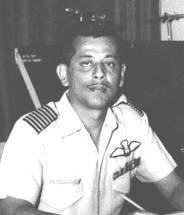 Wing Commander Parker. the Officer Commanding to a fighter bomber squadron [No.20 Squadron, Hunters] led many deep penetration missions into enemy held territory attacking strongly defended targets. While returning from one such mission, his formation was attacked by enemy Sabre aircraft In the ensuing tight. Wing Commander Parker shot down one Sabre and heavily damaged another. In another mission, he attacked the enemy oil refinery at Attock, in the face of the most intense anti-aircraft and small arms tire. seriously damaging the refinery. In all his missions, the actions of Wing Commander Parker have been marked by great courage and determination, and he has been a shining example to the other pilots under his command. His leadership both in peace and war has been outstanding. He has displayed devotion to duty, bravery in the face of heavy enemy opposition and courage in leading many missions day after day. Wing Commander Parker. the Officer Commanding to a fighter bomber squadron [No.20 Squadron, Hunters] led many deep penetration missions into enemy held territory attacking strongly defended targets. While returning from one such mission, his formation was attacked by enemy Sabre aircraft In the ensuing tight. Wing Commander Parker shot down one Sabre and heavily damaged another. In another mission, he attacked the enemy oil refinery at Attock, in the face of the most intense anti-aircraft and small arms tire. seriously damaging the refinery. In all his missions, the actions of Wing Commander Parker have been marked by great courage and determination, and he has been a shining example to the other pilots under his command. His leadership both in peace and war has been outstanding. He has displayed devotion to duty, bravery in the face of heavy enemy opposition and courage in leading many missions day after day. | ||||
| Reference: | Gazette of India , 12th February 1972 - No.20 - Pres/72 dated 20th January 1972 | ||||
| Sqn Ldr | Ravinder Nath Bharadwaj 5001 F(P) | Unit : No.20 Squadron | Award Date 05 Dec 71 | Announced 26 Jan 72 | |
| Details : | 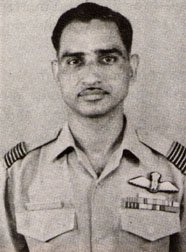 Squadron Leader Bhardwaj, a senior pilot in a fighter-bomber squadron [No.20 Squadron, Hunters] , has led a number of operational missions against a variety of enemy targets. On December 5, 1971, he led a raid on an enemy airfield. Although the target was heavily defended by anti-aircraft and small arms fire, he pressed home the attack. He himself set fire to an enemy heavy transport aircraft in one of his attacks, and eventually led his mission safely back to base. On December 7, 1971 , he led another mission this time to heavily defended power station. Here too, his mission succeeded in causing heavy damage, without any loss to our aircraft. On December 10, 1971, he led a close support mission to the Chhamb area. During the first attack, his aircraft as well as that of his number two were hit by ground fire, and as they pulled out of the attacks they were engaged by enemy Sabres. He guided his number two out of danger, and then returned to the fray shooting down a Sabre which crashed inside our lines near the Chhamb bridge. By this time he was alone, but he returned to the attack, against Pakistani tanks and troops, and caused extensive damage to these targets before nursing his damaged aircraft back to base, where he landed safely. He has displayed exceptional gallantry, leadership and bravery in the face of heavy odds, which are in the highest traditions of the Air Force. Squadron Leader Bhardwaj, a senior pilot in a fighter-bomber squadron [No.20 Squadron, Hunters] , has led a number of operational missions against a variety of enemy targets. On December 5, 1971, he led a raid on an enemy airfield. Although the target was heavily defended by anti-aircraft and small arms fire, he pressed home the attack. He himself set fire to an enemy heavy transport aircraft in one of his attacks, and eventually led his mission safely back to base. On December 7, 1971 , he led another mission this time to heavily defended power station. Here too, his mission succeeded in causing heavy damage, without any loss to our aircraft. On December 10, 1971, he led a close support mission to the Chhamb area. During the first attack, his aircraft as well as that of his number two were hit by ground fire, and as they pulled out of the attacks they were engaged by enemy Sabres. He guided his number two out of danger, and then returned to the fray shooting down a Sabre which crashed inside our lines near the Chhamb bridge. By this time he was alone, but he returned to the attack, against Pakistani tanks and troops, and caused extensive damage to these targets before nursing his damaged aircraft back to base, where he landed safely. He has displayed exceptional gallantry, leadership and bravery in the face of heavy odds, which are in the highest traditions of the Air Force. | ||||
| Reference: | Gazette of India , 12th February 1972 - No.20 - Pres/72 dated 20th January 1972 | ||||
| Wg Cdr | Padmanabha Gautam 4482 F(P) | Unit : No.16 Squadron | Award Date 05 Dec 71 | Announced 26 Jan 72 | |
| Details : | 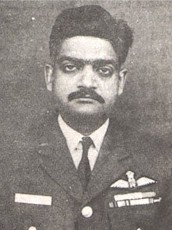 Wing Commander Padmanabha Gautam, MVC; VM, Commanding Officer of a bomber squadron [No.16 Squadron, Canberras] led many missions deep into enemy territory. Notable among these are two raids on the night of December 5th and 7th, 1971,when he led attacks on Mianwali airfield. On both these occasions he and his formation were met with intense anti-aircraft fire. Despite that, the target was attacked with great precision, at low level, and heavy damage was inflicted. On other missions, Wg Cdr Gautam carried out rocket and four gun attacks on railway marshalling yards in the Montgomery-Raiwind area with conspicuous success. Through out the period of operations, Wg Cdr Gautam displayed an ability for cool and clear planning, along with unflinching courage, exemplar flying skill and leadership of the highest order in carrying out many hazardous missions. His conduct has been in the finest tradition of the Air Force. Wing Commander Padmanabha Gautam, MVC; VM, Commanding Officer of a bomber squadron [No.16 Squadron, Canberras] led many missions deep into enemy territory. Notable among these are two raids on the night of December 5th and 7th, 1971,when he led attacks on Mianwali airfield. On both these occasions he and his formation were met with intense anti-aircraft fire. Despite that, the target was attacked with great precision, at low level, and heavy damage was inflicted. On other missions, Wg Cdr Gautam carried out rocket and four gun attacks on railway marshalling yards in the Montgomery-Raiwind area with conspicuous success. Through out the period of operations, Wg Cdr Gautam displayed an ability for cool and clear planning, along with unflinching courage, exemplar flying skill and leadership of the highest order in carrying out many hazardous missions. His conduct has been in the finest tradition of the Air Force. | ||||
| Reference: | Gazette of India , 12th February 1972 - No.22 - Pres/72 dated 20th January 1972 | ||||
| Wg Cdr | Man Mohan Bir Singh Talwar 4573 F(P) | Unit : No.5 Squadron | Award Date 17 Dec 71 | Announced 26 Jan 72 | |
| Details : | 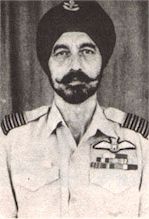 Wing Commander Talwar, Commanding Officer of a Bomber Squadron [No.5 Squadron, Canberras] led five day and night bombing missions against very heavily defended enemy targets within the first 10 days of operations. On one of these missions, he inflicted very severe damage to the Pakistani Air Force installations at Sargodha. In a daylight mission in the Chhamb area, in support of the army, he attacked four enemy gun positions near the Munnawar Tawi river and effectively silenced three of them facilitating the advance of our troops in difficult terrain. Both these targets were heavily defended ; the latter was close to an enemy fighter base from where interception was also likely. Despite this, the officer pressed home his attacks with great determination and much success. His conduct was an inspiration to the crews of the other aircraft which he was leading. The bold leadership, tenacity of purpose, flying skill and bravery displayed by Wing Commander Talwar were largely responsible for the many successes of his squadron. Wing Commander Talwar, Commanding Officer of a Bomber Squadron [No.5 Squadron, Canberras] led five day and night bombing missions against very heavily defended enemy targets within the first 10 days of operations. On one of these missions, he inflicted very severe damage to the Pakistani Air Force installations at Sargodha. In a daylight mission in the Chhamb area, in support of the army, he attacked four enemy gun positions near the Munnawar Tawi river and effectively silenced three of them facilitating the advance of our troops in difficult terrain. Both these targets were heavily defended ; the latter was close to an enemy fighter base from where interception was also likely. Despite this, the officer pressed home his attacks with great determination and much success. His conduct was an inspiration to the crews of the other aircraft which he was leading. The bold leadership, tenacity of purpose, flying skill and bravery displayed by Wing Commander Talwar were largely responsible for the many successes of his squadron. | ||||
| Reference: | Gazette of India , 12th February 1972 - No.20 - Pres/72 dated 20th January 1972 | ||||
| Wg Cdr | Allan Albert D'Costa 4580 F(P) | Unit : No.222 Squadron | Award Date 04 Dec 71 | Announced 26 Jan 72 | |
| Details : | 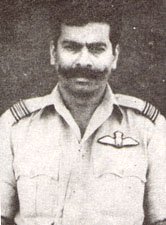 Wing Commander A.A.D'Costa, the Commanding Officer of a Fighter-Bomber squadron [No.222 Squadron, Sukhoi-7], had brought his squadron up to the highest pitch of operational preparedness. His foresight and leadership paid excellent dividends during the war, as he and the Squadron achieved outstanding results. During the war, the officer led no fewer than 15 missions deep into enemy territory against heavily defended targets, thus setting a fine example to his pilots. On December 4,1971 he was the first to strike at the enemy's Risalwala airfield. On the same day he followed up by attacking Chander airfield. On the next day, he led a mission to Chistian Mandi, where he personally accounted for three enemy tanks, as confirmed by films brought back by him. On December 6 he led an attack on a concentration of tanks at Dera Baba Nanak, in the face of the most intense anti-aircraft fire. Although his No. 2 was shot down by this ground fire. he pressed home the attack, with utter disregard for his own safety, destroying a number of tanks and damaging others. On December 7 he carried out a low level photographic reconnaissance mission, in the Sulemanki area and followed this up by leading an attack on the same day, on the railway station at Norowal, where he personally destroyed and damaged many railway wagons, as well as some installations. From December 8 to 12 he flew a number of unescorted reconnaissance missions, bringing back a large volume of intelligence based on which air and ground operations were conducted. Thereafter, up to the end of the fighting, he led missions mainly against railway targets, including the marshalling yards at Raiwind, the Kasur-Lahore railway tracks, destroying a large number of wagons and causing devastation at each target. His constant example of bravery, determination and skill were an inspiration to the pilots of his squadron. Wing Commander A.A.D'Costa, the Commanding Officer of a Fighter-Bomber squadron [No.222 Squadron, Sukhoi-7], had brought his squadron up to the highest pitch of operational preparedness. His foresight and leadership paid excellent dividends during the war, as he and the Squadron achieved outstanding results. During the war, the officer led no fewer than 15 missions deep into enemy territory against heavily defended targets, thus setting a fine example to his pilots. On December 4,1971 he was the first to strike at the enemy's Risalwala airfield. On the same day he followed up by attacking Chander airfield. On the next day, he led a mission to Chistian Mandi, where he personally accounted for three enemy tanks, as confirmed by films brought back by him. On December 6 he led an attack on a concentration of tanks at Dera Baba Nanak, in the face of the most intense anti-aircraft fire. Although his No. 2 was shot down by this ground fire. he pressed home the attack, with utter disregard for his own safety, destroying a number of tanks and damaging others. On December 7 he carried out a low level photographic reconnaissance mission, in the Sulemanki area and followed this up by leading an attack on the same day, on the railway station at Norowal, where he personally destroyed and damaged many railway wagons, as well as some installations. From December 8 to 12 he flew a number of unescorted reconnaissance missions, bringing back a large volume of intelligence based on which air and ground operations were conducted. Thereafter, up to the end of the fighting, he led missions mainly against railway targets, including the marshalling yards at Raiwind, the Kasur-Lahore railway tracks, destroying a large number of wagons and causing devastation at each target. His constant example of bravery, determination and skill were an inspiration to the pilots of his squadron. | ||||
| Reference: | Gazette of India , 12th February 1972 - No.20 - Pres/72 dated 20th January 1972 | ||||
| Wg Cdr | Swaroop Krishna Kaul 4721 F(P) | Unit : No.37 Squadron | Award Date 04 Dec 71 | Announced 26 Jan 72 | |
| Details : |  At the outbreak of hostilities, Wing Commander S K Kaul, the Commanding Officer of a Fighter Bomber Squadron [No.37 Squadron, Hunters], volunteered for an urgent task to photograph certain areas in Bangla Desh. These photographs were badly needed in order to finalise our Army’s assault plans. The officer carried out four missions deep into enemy territories ot cover the heavily defended sectors of Comila, Sylhet and Saidapur. At times, he had to fly as low as 200 feet over the most heavily defended enemy locations. Undaunted, he flew through these barrages, making repeated runs in each of his missions and successfully completed the task. On 4th December 1971, he again volunteered for another task to photograph the Tezgaon and Kurmitola airfields. His reconnaissance flights over these two airfields, in the face of the most sustained and heavy enemy ground fire stood out as acts of heroism, extreme gallantry and devotion to duty. In addition to his reconnaissance exploits, he led the very first eight aircraft strike mission over Dacca. In this raid, his formation encountered four enemy aircraft near the target area. With exemplary leadership, he manoeuvred his forces in such a manner that two of the enemy aircraft could be shot down and the other two fled. The target thus became clear for attack. Throughout the period of operations, Wing Commander Kaul led his squadron boldly, with tenacity and personally displayed courage of an exceptionally high order in the face of the enemy At the outbreak of hostilities, Wing Commander S K Kaul, the Commanding Officer of a Fighter Bomber Squadron [No.37 Squadron, Hunters], volunteered for an urgent task to photograph certain areas in Bangla Desh. These photographs were badly needed in order to finalise our Army’s assault plans. The officer carried out four missions deep into enemy territories ot cover the heavily defended sectors of Comila, Sylhet and Saidapur. At times, he had to fly as low as 200 feet over the most heavily defended enemy locations. Undaunted, he flew through these barrages, making repeated runs in each of his missions and successfully completed the task. On 4th December 1971, he again volunteered for another task to photograph the Tezgaon and Kurmitola airfields. His reconnaissance flights over these two airfields, in the face of the most sustained and heavy enemy ground fire stood out as acts of heroism, extreme gallantry and devotion to duty. In addition to his reconnaissance exploits, he led the very first eight aircraft strike mission over Dacca. In this raid, his formation encountered four enemy aircraft near the target area. With exemplary leadership, he manoeuvred his forces in such a manner that two of the enemy aircraft could be shot down and the other two fled. The target thus became clear for attack. Throughout the period of operations, Wing Commander Kaul led his squadron boldly, with tenacity and personally displayed courage of an exceptionally high order in the face of the enemy | ||||
| Reference: | Gazette of India , 12th February 1972 - No.20 - Pres/72 dated 20th January 1972 | ||||
| Gp Capt | Chandan Singh 3460 F(P) | Unit : 10 Wing | Award Date 07 Dec 71 | Announced 26 Jan 72 | |
| Details : | 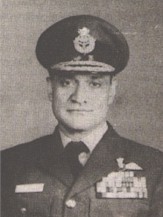 Group Captain Chandan Singh, AVSM. VRC is the officer commanding of an Air Force Station in the East [Air Force Station, Jorhat]. During the war with Pakistan, he was in the forefront of the air operations conducted for the liberation of Bangla Desh. Group Captain Chandan Singh was also responsible for the planning and execution of the special helicopter operations to airlift two companies of troops of the Sylhet area. When it became necessary to overcome the obstacles in the advance of the army towards Dacca, he planned and executed the move of nearly 3,000 troops and 40 tons of equipment and heavy guns with the extremely limited helicopter force at his disposal. This operation entailed landing the troops and equipment near heavily defended areas by night. Prior to each mission he personally carried out reconnaissance in the face of heavy enemy fire. On the night of December 7/8 he flew eight missions, deep into enemy territory to supervise the progress of the helicopter airlift and to guide and inspire his pilots who were facing heavy opposition from ground tire. Later he undertook a further 18 missions in the same operation, always leading the landings at new places. On many occasions his helicopter was hit by ground fire, but this did not deter him from further missions. The success of this major airborne operation contributed significantly to the fall of Dacca and the capitulation of tie Pakistan armed forces, in Bangla Desh. The leadership, drive and determination coupled with the bravery shown by Group Captain Chandan Singh over an extended .period of time, are in the highest traditions of the Air Force. Group Captain Chandan Singh, AVSM. VRC is the officer commanding of an Air Force Station in the East [Air Force Station, Jorhat]. During the war with Pakistan, he was in the forefront of the air operations conducted for the liberation of Bangla Desh. Group Captain Chandan Singh was also responsible for the planning and execution of the special helicopter operations to airlift two companies of troops of the Sylhet area. When it became necessary to overcome the obstacles in the advance of the army towards Dacca, he planned and executed the move of nearly 3,000 troops and 40 tons of equipment and heavy guns with the extremely limited helicopter force at his disposal. This operation entailed landing the troops and equipment near heavily defended areas by night. Prior to each mission he personally carried out reconnaissance in the face of heavy enemy fire. On the night of December 7/8 he flew eight missions, deep into enemy territory to supervise the progress of the helicopter airlift and to guide and inspire his pilots who were facing heavy opposition from ground tire. Later he undertook a further 18 missions in the same operation, always leading the landings at new places. On many occasions his helicopter was hit by ground fire, but this did not deter him from further missions. The success of this major airborne operation contributed significantly to the fall of Dacca and the capitulation of tie Pakistan armed forces, in Bangla Desh. The leadership, drive and determination coupled with the bravery shown by Group Captain Chandan Singh over an extended .period of time, are in the highest traditions of the Air Force. | ||||
| Reference: | Gazette of India , 12th February 1972 - No.20 - Pres/72 dated 20th January 1972 | ||||
The Awards Database presented here was made possible by the kind generosity of Air Marshal Bharat Kumar, author of Courage & Devotion to Duty : A Chronicle of IAF's Honours and Awards (1932-2008). Air Marshal Bharat Kumar had very graciously given permission to reproduce the citations from the book on this website.
The URL for this page is Here is a Clickable Link Pages 1
Note: All the data available here is publicly available in the Gazette of India, published by the Indian Government, or from public domain sources, press releases about Awards and Right-To-Information (RTI) Requests. Additionally data shared by veterans is added to the page with permission. No data with respect to serving officers below the rank of AVM is displayed. Information in Gazette of India and Award citations and photographs as released by the Indian Air Force are the only details displayed.
